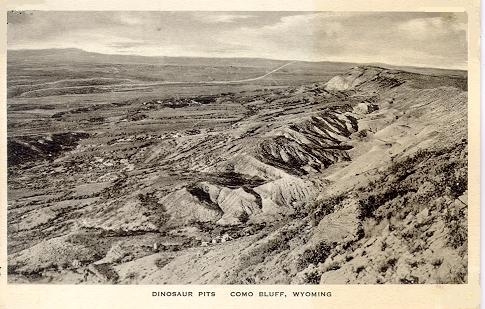
Como Bluff dinosaur grave yard, 1934
To the west of Rock River and to the east of Medicine Bow lies Como Bluff. In the popular mind, Wyoming may be associated with
Indian Wars, Range Wars, and Sheep Wars. Yet the Territory and Como Bluff was at the center of another
war which gripped the public's attention during the last third of the 19th Century, a war
which involved Indians, F. V. Hayden, John Wesley Powell, Yale University's
Peabody Museum, the Philadelphia Acadamy of Natural Sciences, and the Smithsonian. Indeed, echoes of that war
continue to reverberate today -- "The Bone Wars."
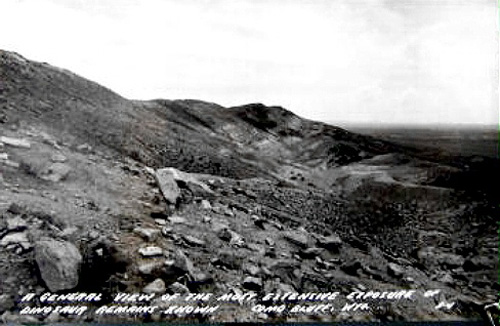
North Slope, Como Bluff dinosaur grave yard, 1934
In the 1860's paleontologists rarely collected their own specimens. It was common for collectors in the
field to send fossils to a paleontologist for classification. Dr. Hayden's fossils were classified by Edward Drinker Cope (1840-1897).
Cope had been for a time a student of Joseph Leidy. Leidy, himself, about 1868, began receiving fossils from
two of Judge Carter's sons-in-law, James Van Allen Carter and Joseph K. Corson. Carter, not related to Judge
Carter, had married Judge Carter's daughter Anna and Corson married Ada. Corson was an assistant surgeon at Fort
Fred Steele and later post surgeon at Fort Bridger. In 1872, Leidy visited Fort Bridger and was taken into the forbidding Washakie
Basin by Carter and Corson. The Basin was described by Leidy as "an utter desert, a vast succession of
treeless plains and buttes, with scarcely any vegetation and no signs of animal life." Indeed, he
wrote, it was "undisturbed even by the hum of an insect." At the same time, Yale Professor Othniel Charles Marsh (1831-1894) began a
series of expeditions into the west to gather fossils. In 1877, Railroad workers discovered large bones near
Como Bluff and notified Professor Marsh. Thus, it was discovered that while Wyoming may
have been scarce in living fauna, it was rich in extinct life. The competition, like the competition for the
last girls in a saloon before closing hour, was on between Marsh and
Cope. Each had egos larger than the Uintatherium robustum discovered by Leidy. The
uintatherium, named after the Uinta Mountains, was a eocene mammel looking much like a cross between a
hippopotamus and an elephant. Cope, in fact, thought it to be related to the elephant and, thus,
in a drawing put elephant ears on the animal. Both Cope and Marsh had more Uintatherium fragments
than Leidy and, thus, both attacked Leidy and each other. Leidy, caught in the middle between the two, withdrew
from further exploration in the West.
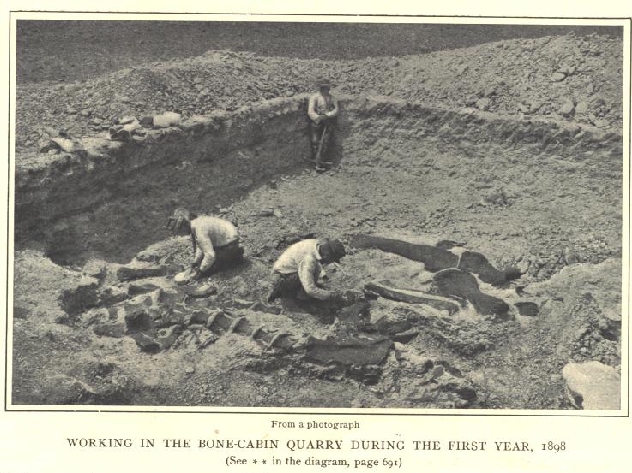
Excavation at Bone Cabin Quarry, 1898, Photo from Century Magazine, 1904
The Bone Cabin Quarry at Como Bluff took its name from
the fact that a cabin belonging to a local trapper was made of dinosaur bones.
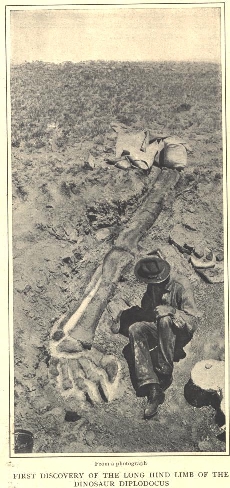 Diplodocus Leg and Foot, Como Bluff, 1898
Diplodocus Leg and Foot, Como Bluff, 1898
The Quarry, about ten miles from Como Bluff, was discovered in 1897 by Walter Granger (1872-1941). After 1903, Granger diverted his
attention to Paleocene and Eocene mammels. He primarily devoted his attention to Wyoming
from 1903 to 1918. Others who worked in the
area included Edward Drinker Cope and Othniel Charles Marsh discussed below, and Barnum Brown, discussed with regard
to the Bighorn Basin. In one year alone, some 30 tons of dinosaur bones consisting of some
141 individuals were removed from the quarry.
Originally, Cope and Marsh were friends,
having met at the University of Berlin and having a common interest in the study of fossils.
Marsh established himself as a professor at Yale without teaching duties as a result of a
generous endowment by his uncle, George Peabody.
Cope was associated with the Philadelphia Acadamy and
relied on his own personal fortune. Following an expedition to Kansas in which both
participated, Cope assembled a skeleton of an Elasmosaurus, a marine
sauropod, and published a paper concerning his discovery. Unfortunately, Cope, in his haste
to announce to the world his new discovery, placed the head on the wrong end; that is, the
head was placed on the tail. When the error was discovered, Cope immediately began buying back at
his own expense all of the papers with the erroneous illustration. Marsh, however, not
missing an opportunity to enhance his own reputation, made sure the whole world knew of
his former friend's error and took delight in exposing Cope. Marsh sarcastically wrote that
Cope should have named the elasmosaurus "Steptosaurus," "twisted reptile."
[Writer's note:
Marsh made a similar error. It, however, was not acknowledged by the Peabody for more than 100 years.
Marsh placed the wrong head on a skeleton of a brontosaurus.
The Brontosaurus was used as a model for Brontosuauri all over the world. The error,
however, was not corrected by the Peabody until 1981 and required exhibits in
museums throughout the world to be changed.]
Additionally,
Marsh began bribing Cope's workers to send him, Marsh, new fossils from Cope's
fossil pits in New Jersey. The result was an animosity between the two. The animosity impacted on the U.S. Geological
Survey with each backing different candidates for Director, Cope backing Dr. Hayden and Marsh backing
John Wesley Powell.
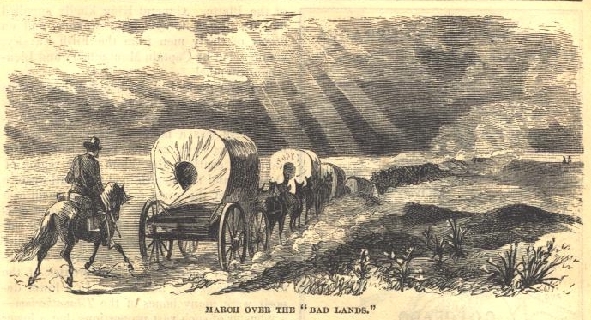
Marsh Expedition of 1870, engraving from Harper's New Monthly Magazine, 1871
Things boiled over, however, in Wyoming. Both Cope and Marsh conducted expeditions to the Territory; Marsh using the
military to provide protection against the Indians. Marsh used his influence interfered with Cope's ability to obtain
accomodations or assistants at Fort Bridger and Cope was required to sleep in the Fort's hay yard.
On Marsh's first expedition in 1870, Wm. F. Cody acted as
a guide for the first leg of the journey. Cody remained a life-long friend
of Marsh and would visit with him every time Cody's
show would play in New Haven. In 1879, Cope showed up at the Como Bluff accusing Marsh of
"trespassing" and stealing his fossils. Marsh directed that
the dinosaur pits be dynamited rather than allow fossels to fall into the "wrong hands." On another occasion,
Cope had a train load of Marsh's fossils diverted to
Philadelphia. Marsh, in turn, would attempt to delay Cope's work by salting Cope's digs with odd pieces of bone fragments unrelated
to the fossils from the period in question.
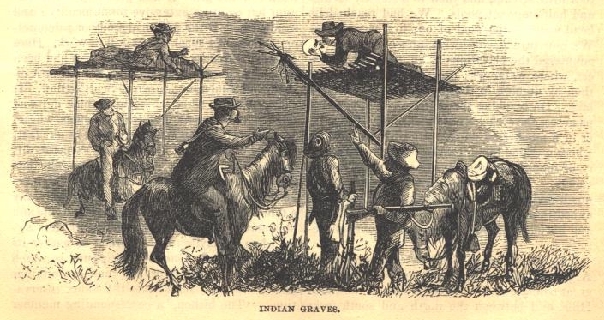
Indian Funeral Platforms, Marsh Expedition of 1870, engraving from Harper's New Monthly Magazine, 1871
On the expedition, Marsh crossed Lakota lands without permission in violation of the
1868 Treaty of Ft. Laramie. Nevertheless, Marsh seemed unconcerned about the Indians. As indicated by the
above engraving, the expedition came across an Indian funeral platform, upon which rested the
bodies of a man and woman, beneath lay the skeleton of a pony. It was the custom of some
tribes of American Indians to place the bodies of the deceased on platforms with
tokens of respect such a food. Additionally, there might be sacrificed as a token of
honor a horse. After a period of time, some tribes would return and gather the bones of the
deceased. Marsh's attitude was indicated by his admonition to the students:
"Well, boys, perhaps they died of small-pox; but we can't study the origin of the Indian race
unless we have those skulls!"
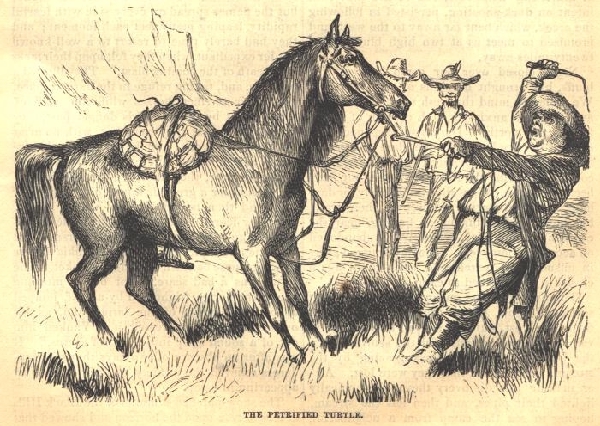
Turtle Fossil on Back of Horse, Marsh Expedition of 1870, engraving from Harper's New Monthly Magazine, 1871
Notwithstanding the concern by other members of the expedition as to ever more close smoke
from Indian fires ahead, Marsh seemed only concerned with the collection of fossils. In one instance,
he recovered the fossil of a giant turtle. While others wished to proceed in order
to avoid a confrontation with the Indians, Marsh's only concern, regardless of the reluctance of the
horse, was the exhibition of the turtle in his museum in New Haven.
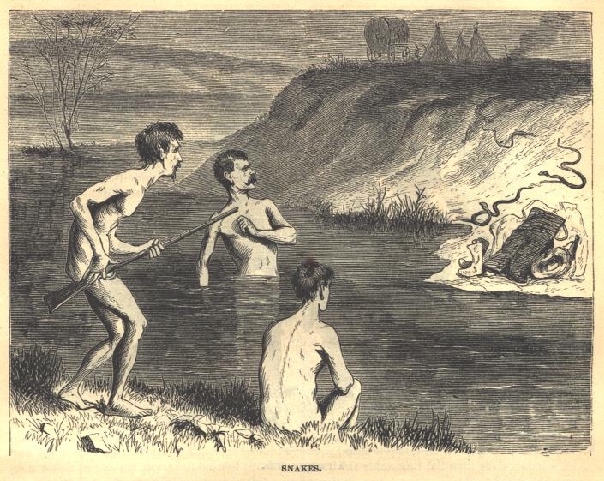
Students Surprised by Snakes, Marsh Expedition of 1870, engraving from Harper's New Monthly Magazine, 1871
Other hazards faced the expedition. In one instance, while the students were bathing, an invasion of
snakes occurred.
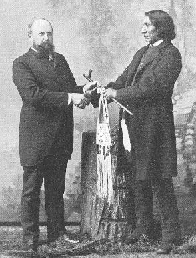 Red Cloud and Prof. O. C. Marsh, 1883
Red Cloud and Prof. O. C. Marsh, 1883
The Expedition was saved from being attacked by the Indians only
by the fact that Marsh had personally befriended Red Cloud by promising to
intercede with the Great Father on behalf of the Indians. Marsh kept his word. In 1883,
Red Cloud visited New Haven and called upon Professor Marsh. Red Cloud observed:
"I remember the wise chief. He came here and I asked him to tell the Great Father something.
He promised to do so, and I thought he would do like all white men, and
forget me when he went away. But he did not. He told the Great Father
everything, just as he promised he would, and I think he is the best
white man I ever saw."
Cope had a different way of dealing with the Indians. When visiting Indian
camps, he would amuse them by taking out his false teeth. The Indians were fascinated
by an individual who could remove and then replace his teeth. Cope was the more affable of the two. Behind his back,
Marsh was referred to at one of his clubs as the "Great Dismal Swamp." In contrast, one of
Marsh assistant's Arthur Lakes, from the Colorado School of Mines, was surprised to discover upon
meeting Cope, that Cope, rather than the Monstrum horrendum Lakes was expecting, was actually quite
friendly.
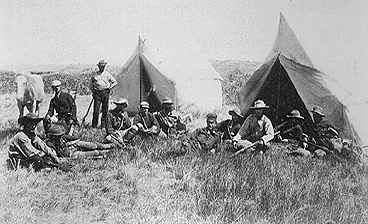 Marsh Expedition of
1870 Marsh Expedition of
1870
In total, Marsh personally conducted four expeditions into Wyoming between 1870 and 1874. After that time, members
of his staff would conduct the excavations and ship the fossils back to New Haven.
Pictured, left to right,
George Bird Grinnell, Bill the cook, Charles Wyllys Betts, O.C. Marsh (standing), Alexander Hamilton Ewing, Henry Bradford Sargent, Eli Whitney (grandson of
the inventor), Harry D. Ziegler, Charles T. Ballard, John Reed Nickolson, Charles McC. Reeve(? possibly John Wool Griswold), Charles Matson Russell. Grinnell later
became the senior editor and publisher of Forest and Stream which was
influential in the American conservation movement. Grinnell was invited by George Armstong Custer to accompany his
1876 expedition into the Black Hills as the expedition's naturalist. Fortuitously, Grinnell had another engagement and
declined. He also was the founder of the original
Audubon Society (discontinued in Jan. 1889) and is regarded as the "Father of Glacier National Park".
The animosity, nay, the hatrid one for the other, finally became public in January 1890. Cope had while on
federally financed expeditions gathered numerous fossils, spending some $80,000.00 in his own funds on
the effort. Nevertheless, in 1889 the federal government required that the fossils be turned over
to the government. Cope blamed Marsh who had been sucessful in obtaining the upper hand with the
Geological Survey. Thus, in an article in the New York Herald written by W. H. Ballou, a friend of
Cope, Cope blasted Marsh with both barrels. Marsh had written a monograph on the evolution of the horse. Cope
accused Marsh of stealing the work of Russian vertebrate paleontologist Vladimir Kowalevsky who had earlier
written on the same subject. He claimed that his rival's work was "the most remarkable collection of
errors and ignorance of anatomy and literature on the subject ever displayed." In one sense, Marsh did have a
remarkable collection of errors. Over the years, Marsh had been lovingly collecting every perceived error that
Cope had ever made.
The following week, Marsh responded in kind. Using his collection of errors, he claimed that Cope had committed "a series of blunders, which are
without parallel in the annals of science." Marsh indicated that when the first two had met in
Berlin, he suspected Cope's sanity. With regard to Kowalevsky, Marsh alleged that Kowalevsky "was at least
striken with remorse and ended his unfortunate career by blowing out his brains," but, Marsh continued, "Cope still
lives, unrepentant." In his haste to respond, Marsh was in error as to Kowalevsky. Although,
Kowalevsky committed suicide as a result of his penury, he did not shoot himself. He used
chloroform. While the public denunciations of each other were of short lived interest, the wounds inflicted by
Cope on Marsh had an ultimate impact. Marsh wrote and published at his own expense a monograph on toothed birds.
It was read by several congressman, with the result that Marsh was fired from his work with the
Geological Survey as an example of the waste of public money.
The end result of the Bone Wars was that each exhausted their respective fortunes. Cope had to sell part of
his collections. Marsh had to mortgage his house and beg Yale for a salary, the
endowment from his uncle having been spent. Today,
Cope is regarded as the more intellectual of the two, but is regarded as careless.
Marsh is considered to be the better politician and was more
careful in his work. Marsh has been accused of taking credit for the work of his students.
Echoes of the Bone War reverberate today. Today great controversy
exists among paleontologists as to whether birds are descended from
dinosaurs. The theory was first proposed by Marsh in 1877.
|